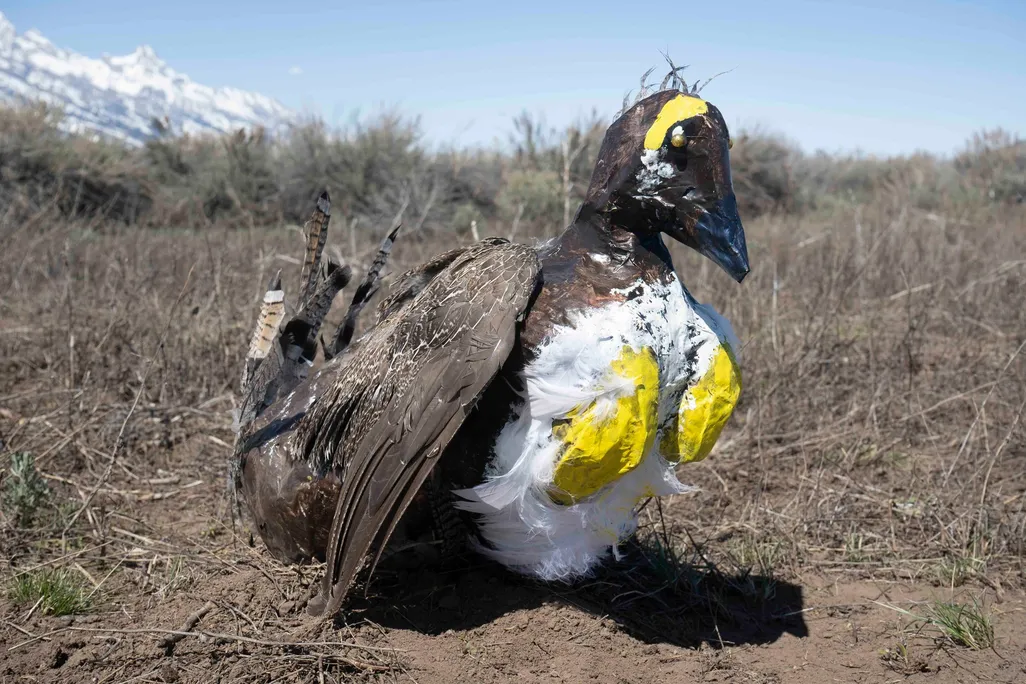WWW.SMITHSONIANMAG.COM
Threatened Birds Are Trying to Mate Near a Hazardous Airport in Wyoming. Can Papier-Mâché Decoys Lure Them to Safety?
Threatened Birds Are Trying to Mate Near a Hazardous Airport in Wyoming. Can Papier-Mâché Decoys Lure Them to Safety?
At Grand Teton National Park, officials have placed handmade look-alikes in a field south of the runway to encourage greater sage-grouse to relocate
The papier-mâché decoys have been placed in a 100-acre field south of the Jackson Hole Airport runway in a bid to attract greater sage-grouse.
NPS / M. Nall
Every spring, amorous male greater sage-grouse strut their stuff in western North America. These chunky, round birds put on an eye-catching show to impress any nearby females: They inflate the bright yellow air sacs on their chests, fan out their tails, thrust their heads and make burbling noises.
Birders travel for miles to witness these impressive dances, which take place on mating grounds known as “leks.” But sometimes, the birds inadvertently select lek sites that are near human-made hazards—like right next to the Jackson Hole Airport. Between 1990 and 2013, 32 greater sage-grouse were struck and killed by planes near the runway, according to an Instagram post from Grand Teton National Park.
Now, officials have come up with an innovative solution to this problem: They’re using papier-mâché decoys to encourage the greater sage-grouse to relocate to a safer lek site.
“Can papier-mâché save lives?” reads to the post. “We’re about to find out… hopefully.”
Greater Sage-Grouse
Watch on
The Jackson Hole Airport is located within Grand Teton National Park, so wild animals are regular visitors, along with adventurous vacationers who come to ski, hike and soak up Old West culture. In a bid to improve safety for both wildlife and humans, the National Park Service developed a wildlife hazard management plan for the airport several years ago.
As part of that plan, they worked with community partners to restore a 100-acre field just south of the runway. Called the McBride site, the swath was once a historic homestead but is now being transformed into optimal sage-grouse habitat. Over the last few years, biologists have been working to remove an invasive grass called smooth brome and replace it with a mix of low-lying grasses, shrubs and other plants.
So far, their plan seems to be working. Officials have started to find grouse droppings on the field, which they call “white Cheetos” because of their visual similarities to the popular snack, reported the Jackson Hole News & Guide’s Billy Arnold in 2023. The number of grouse visiting the lek at the Jackson Hole Airport has also declined, but officials aren’t sure whether that’s because the birds are dying off or opting to relocate.
On the McBride site, the National Park Service has also been clearing away an invasive grass called smooth brome and replacing it with low-lying grasses, shrubs and other plants.
NPS / M. Nall
This spring, they’re hoping to make the McBride site even more attractive to the grouse by setting up four handmade decoys. The papier-mâché birds were created in partnership with local artist Lori Solem, as well as the Teton Raptor Center and Jackson Hole Middle School art students.
Now, the park service must wait and see whether the papier-mâché look-alikes fool the real greater sage-grouse. They’ve set up trail cameras to keep tabs on the project’s progress.
Next year, officials hope to up the ante even more by placing animatronic greater sage-grouse replicas on the field. They’re partnering with students on the Jackson Hole High School’s robotics team, called the RoboBroncs. The robotic birds are still a work in progress, but when they’re all finished, the students hope they will be able to perform mock mating dances.
Ideally, when the real greater sage-grouse see their robotic counterparts doing their mating displays, they will be tempted to relocate to the field.
“If there’s a really cool bar and you want people to go to the bar, you turn up the music and you have everyone come,” says Gary Duquette, who coaches the robotics team, to the Jackson Hole News & Guide’s Christina MacIntosh. “But then if you show up and no one’s there, you’re like, ‘This is lame.’ So, we’re providing the birds partying and doing their little dances.”
This is not the first time decoys have been used to attempt to change bird behavior. In 2015, two students in Wyoming created similar papier-mâché replicas to encourage greater sage-grouse to move their lek away from a loud oil-drilling rig that had been set up in the area.
In the 1970s, pioneering ornithologist Stephen Kress famously placed carved wooden decoys on the coast of Maine to attract Atlantic puffins. Since then, biologists have used decoys to lure many other species, including Laysan albatrosses, terns, flamingoes and black-crowned night herons.
The greater sage-grouse lives on the sagebrush steppe in western North America. But, in recent decades, the species’ population has been declining because of habitat loss and fragmentation. The birds are sensitive to noise, human presence and other disturbances, especially on their leks.
In the Jackson Hole valley, just seven leks remain: six in Grand Teton National Park and one in the nearby National Elk Refuge, per the Jackson Hole News & Guide.
The birds’ population has gone up and down over the last few decades, but it now appears to be declining. In 2015, biologists counted 180 males in the Jackson Hole subpopulation. After several harsh winters, that number plummeted to 40 males in 2019. However, it rebounded to around 90 males in 2023, per the Jackson Hole News & Guide.
More broadly, greater sage-grouse numbers have plunged across the American West. Since 1965, the population has dropped by 80 percent, according to the U.S. Geological Survey.
Get the latest stories in your inbox every weekday.
